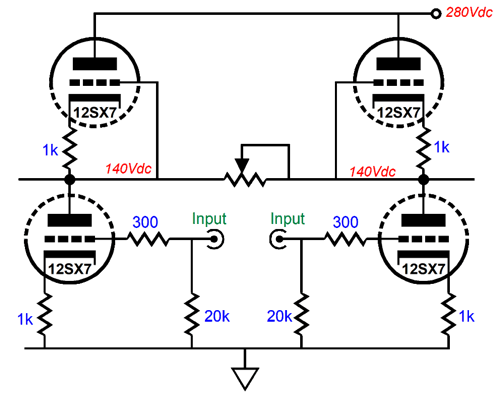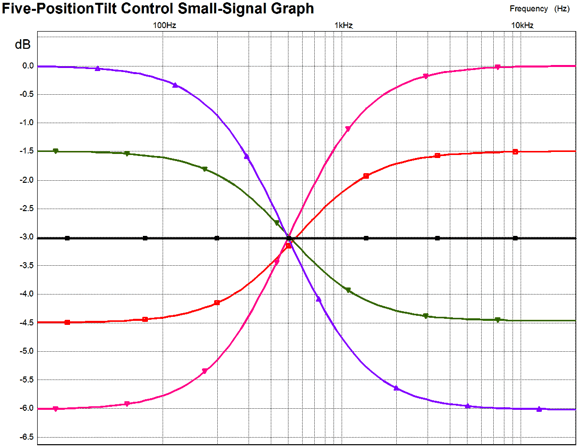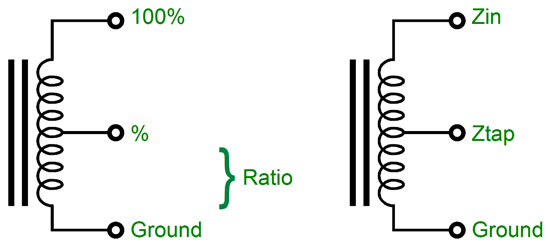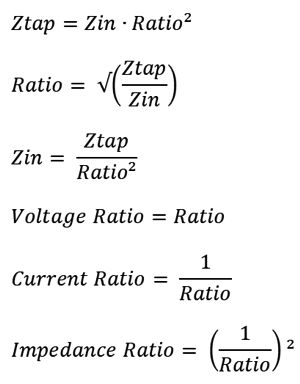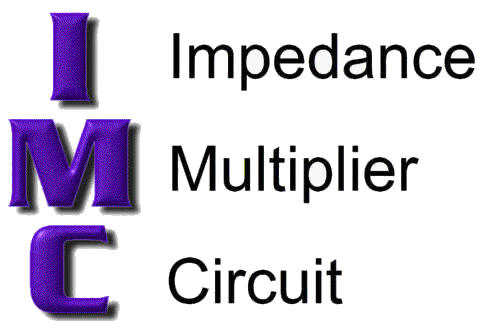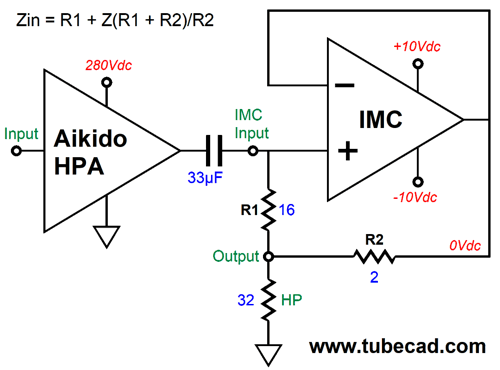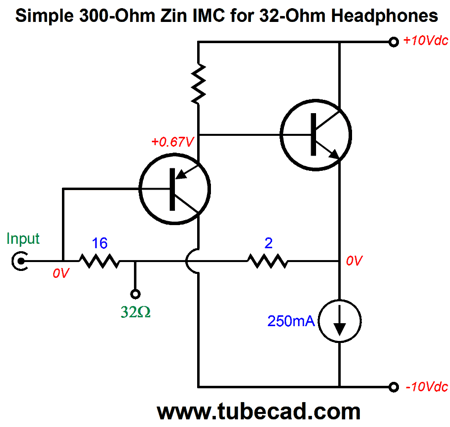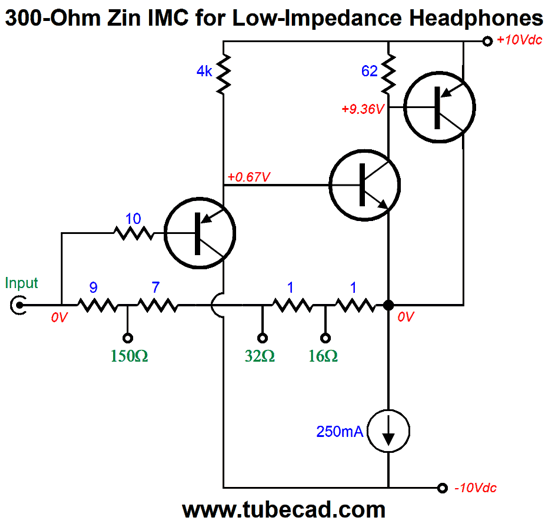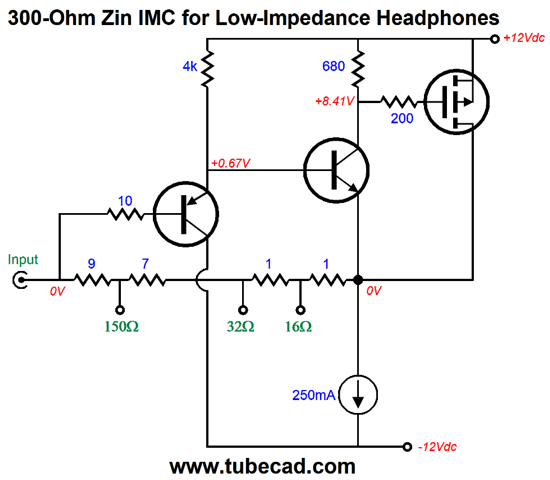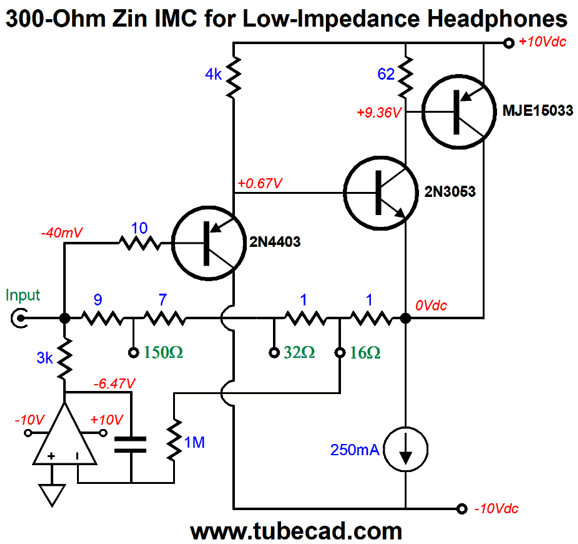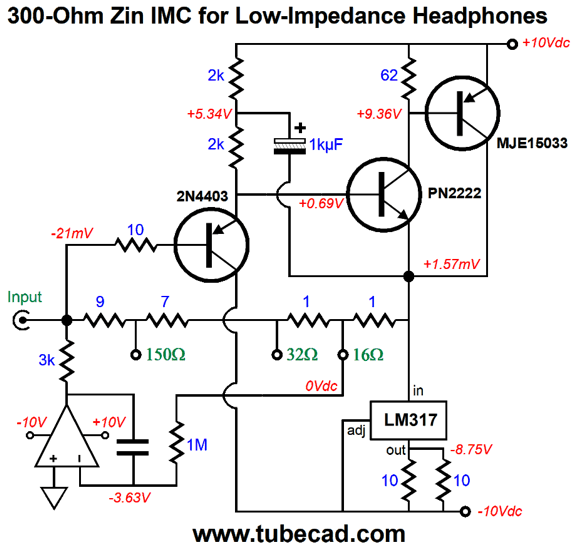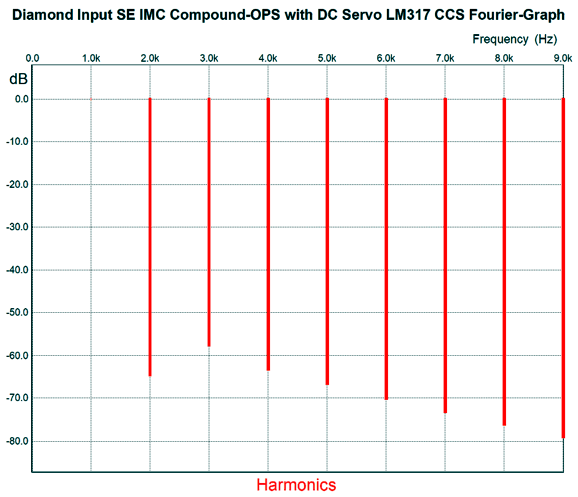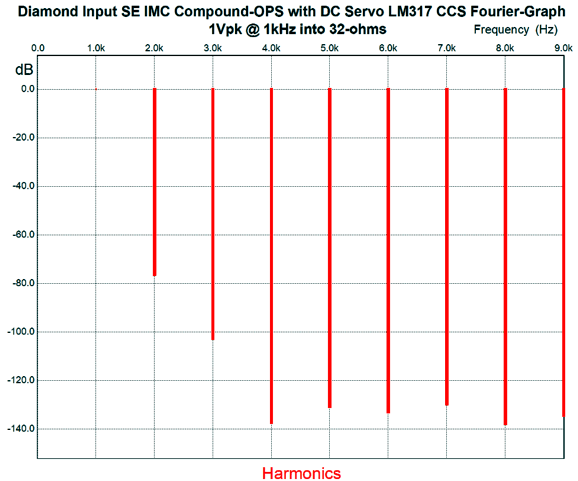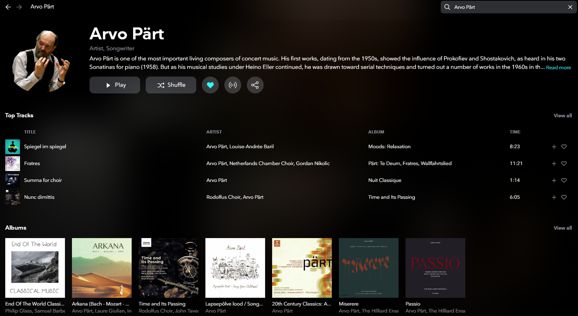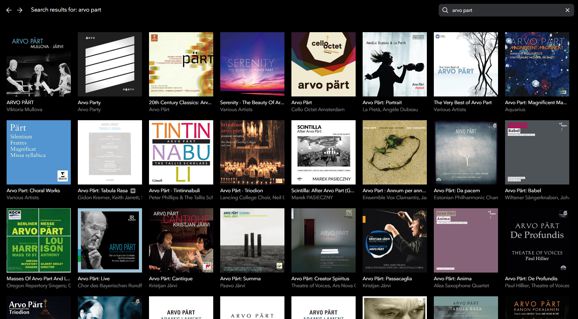| John Broskie's Guide to Tube Circuit Analysis & Design |
29 November 2019 Post Number 484
Happy Black Friday and Cyber Monday
Variations on a headphone Amplifier The stereo-to-mono blend control, which uses the second Trim-1 stepped attenuator, works with either tilt control, as it appears mid circuit, not at the input.
Gil's email sent my mind down the path of three-knob headphone amplifier layouts. Once again, the assumption was that no volume control is not needed, although a mute switch would certainly be welcomed, as so many signal sources already contain their volume control. This brings up an odd discovery I made. When listening to loudspeakers, I often feel the need to adjust the balance between channels. As little as a 1dB imbalance will irk me. Not so with headphone listening. In other words, the same recording imbalance that annoys me when heard from loudspeakers, passes unnoticed when wearing headphones. Why? My guess is that creating a believable stereo acoustic image is supremely difficult with just two speakers—if for no other reason that our listening room fights our efforts. In contrast, headphone listening bypasses the room altogether and the sonic landscape it presents is entirely unnatural, with musicians seemingly playing inside your skull. As for the stereo-to-mono blend control, if you listen primarily to contemporary music, you probably would never use it. In contrast, if you listen to music recorded between 1955 to about 1970, this sonic control comes in handy. When stereo LPs first appeared, the public wanted their stereo good and hard, or rather good and hard.
The Tilt Control sometimes proves useful with overly dull or bright recordings, but I find it most useful to overcome a headphone's mismatch with the music genre. For example, my Audioquest and Grados depict jazz and rock well, but falter with classical. My Sennheiser headphones were born to play back classical, but stumble with rock. Yet, with one twist of the Tilt Control, each headphone becomes universally capable. Okay, here is how I would layout the same 17in wide by 3in tall by 10in deep chassis for three knobs: Tilt Control, stereo-to-mono blend control, and power switch. Ideally, we want the Tilt Control, stereo-to-mono blend control to be located as close to the Aikido PCB and the power switch as far away as possible. Note that the enclosure feet align with the knobs, as do the tubes. A nice touch, no? By the way, Gil also wanted to know if the PS-3 and LV-Reg could be replaced with a PS-21. Yes. In fact, the Aikido noval stereo PCB might be the best choice, as we have so many more tube choices, such as the 6N6 and 6H30 and ECC99.
Driving Low-Impedance Headphones You can see the reason that output transformers were created. With an output transformer we can retain the 33µF coupling capacitors and single 6SN7 output tube per channel. In other words, what we need is a good 32-ohm to 300-ohm output transformer. Unfortunately, no one makes it, as far as I know. Another, and certainly a better choice, choice would be an autoformer.
The autoformer is like an inductor with several taps along its length; it like an output transformer with only a primary. Many theoretical reasons exist for why an autoformer is preferable to an output transformer, such as wider bandwidth and smaller size. Its big liability is that it offers no DC isolation. Nonetheless, the autoformer still offers great protection to the headphones, as its DCR effectively shunts the headphone coil at DC voltages.
This autoformer presents a 300-ohm load to the headphone amplifier, but can drive 16-ohm headphones (and 32, 40, 50, 75, and 150-ohm headphones). Its require inductance can be found with this simple formula: Inductance = Z/(2 ∙pi∙Freq) where the inductance is in Henries. In this example, 300/(2 ∙3.14∙20Hz) equals 2.4H. In other words, we can expect that many turns of wire will be needed around a high-quality core. By the way, the core need not hold an air-gap, as no sustained DC current is expected due to the 33µF coupling capacitor.
I have toyed with the idea of having this very autoformer actually made, but the needed number of autoformers to ensure a decent price is daunting in the extreme.
Solid-State Solutions What do you mean your IMC? I was certain that the IMC had to already exist, as it seemed so obvious. Yet, after exhaustive searches in electron textbooks, Google searches, and patent searches, no previous progenitor was found, so I claim paternity. It turns out that I am more polyphiloprogenitive than I imagined. The IMC consist of a unity-gain buffer and two resistors, which set the impedance multiplication ratio.
The 16-ohm and 2-ohm resistors add up to 18 ohms, which divided by 2 ohms yields a ratio of 9:1. We then multiply 32 ohms by 9 and get 288; to this sum we must add R1's resistance of 16 ohms, resulting in 304 ohms as the load resistance the tube headphones sees at its output. Where do we get a unity-gain power buffer? Well, we could use a BUF634 or LT1010. Or, we could roll our own. The simplest IMC I can envision is a two-transistor diamond configuration. (If it helps, imagine the constant-current source replaced by a 40-ohm power resistor.) The PNP input transistor functions as an emitter follower, as does the NPN transistor, so no voltage gain, but plenty of current gain. Note how the NPN transistor's emitter as at ground potential (roughly, that is), as the two base-to-emitter voltage drops cancel. We can get better performance by supercharging the NPN transistor in a compound configuration. The enslaved PNP transistor is under the NPN transistor's control, which results in greatly reduced distortion and output impedance. The constant-current source loading means that the IMC runs in strict class-A mode and that the enslaved transistor never cuts off, which can prove to be a source of problems in a class-B or class-AB output stages. Instead, we could enslave a P-channel MOSFET. Note that I sneakily added more IMC output taps for different load impedances. Note the increased bipolar power supply voltages, which are needed to encompass the MOSFET's much higher gate-to-source turn-on voltages (lateral MOSFETs are exempted). In other words, without the higher power-supply rail voltages, we could not get as big of output voltage swings from the MOSFET. Okay, earlier I wrote " roughly, that is" in regard to the output DC offset. We can sidestep the problem of DC offsets by using an output coupling capacitor on the IMC. Here is where the IMC's low-voltage power supply comes in nicely, as we can get away with using non-polarized electrolytic coupling capacitors, which are easily available in a 16V voltage rating. On the other hand, if we wish to retain the DC output coupling, we could use a DC servo. The OpAmp should hold a FET input stage and it can be powered by the IMC's bipolar power supply. Note that while we eliminated the Dc offset at one end of the IMC, but not at its input. With 16-ohm headphones, the DC offset will equal 1/17 the 40mV, or 5.7mV, as the string of resistors function as a two-resistor voltage divider. Okay, now let's move on to what I would actually build. The LM317 functions as the constant-current source and the PN2222 replaces the 2N3053, as the latter transistor is hard to find. The 1kµF capacitor bootstraps the 2N4403's emitter resistor so that it behaves more like a constant-current source. Note, that with the change in transistors, the DC offset has almost halved. How well does this IMC work? Here is the SPICE-generated Fourier graph for 4Vpk at 1kHz into a 16-ohm load, which is at this IMC's current limit. Not bad at all. Note the single-ended cascade of harmonics, once we get past the 2nd. By the way, 4Vpk is huge, as it equals 500mW of power and the limit of the constant-current source's flow. Here is the graph for 1Vpk into 32 ohms at 1kHz.
Bear in mind, these graphs only show the IMC's distortion and do not include the tube headphone amplifier's contribution. I did, however, include the Aikido's output impedance in the circuit simulation. The way we would hook up the IMC is to use two headphone jacks, one switching and one non-switching.
When the headphone plug inserts into the a switching jack, the left and right channel signals break with two switch contacts that only engage when the plug has been retracted. The switching jack is where 300-ohm headphones go, while all the other lower impedance headphones go into the non-switching jack. (But not both at once!) When the plug is inserted in the switching jack, the IMC is disconnected from the signal. When headphones are plugged into the non-switching jack, the IMC connects to the Aikido headphone amplifier's output. Here is a three-knob layout. A Tilt Control and an impedance selector switch join the power switch to complete the ensemble.
Music Recommendation: At first, contemporary Arvo Pärt and sixteenth-century's Giovanni Pierluigi da Palestrina might seem an odd pairing, but not really, as both composers have created timeless music. Palestrina influenced Bach, which in itself is enough for us to take note of his music. Although Palestrina was considered the king of Renaissance polyphony, Milton Cross' Encyclopedia of the Great Composers and Their Music omits him, jumping from Paganini to Prokofiev. Born in 1935, Estonian composer Arvo Pärt lives. Thank God. Today, he is a German citizen, having lived in Germany since 1981, but has returned to Estonia. I love his music and I have since the mid 1980s, when no one knew who I was proclaiming the world's greatest living composer. I have two stories to tell about Arvo Pärt. The first is that the head of the Estonian Chess Society once told me that while Pärt was no doubt good, indeed very good, he was only Estonia's second best composer, with Eduard Tubin holding the first place honor. The second story came from a fellow classical music lover who had invited Pärt to her house for lunch, after having had heard him speak at a local college. She told me she was fearful of the encounter due to her children being feral (her description) creatures, uncouth and desultory. She said once Pärt in entered her house, her children grew clam and perfectly well-behaved. His large hands and his expressive hand gestures seemed to memorize all who gazed upon them. Once he left, her children devolved to their usual barbarity. As you have come to expect, I will now point out that this album and many more are available at Tidal. Enjoy.
Having said all this, it's now time complain about Tidal. As I have accused Tidal many times before, Tidal does not get classical music—at all! Tidal recognizes that albums have titles and artists and music tracks. Great, we are half way there. The missing half is compositions and composers. When I click on the classical genre at Tidal, I should be able to search by compositions and composers and eras and sub-genres and nationalities. Yes, nationalities. For example, Estonia is small country, but she has mothered about twenty composers of note. Here is why I am complaining today: when I make a search in Tidal, I have zero guarantees that the search is exhaustive. For example, I enter "Arvo Pärt" and Tidal tells me that I can choose from seven albums.
But when I enter "Arvo Part" and Tidal tells me that I can choose from gobs and gobs albums.
In this extended list, we find many great albums. But I have no way of knowing that this list is truly exhaustive. Why? For Tidal, composer is not a category, but artist is. Thus, if we searched for something like the Estonian Boys Choir, we might surface some hitherto hidden Arvo Pärt music. What a mess.
//JRB
User Guides for GlassWare Software
For those of you who still have old computers running Windows XP (32-bit) or any other Windows 32-bit OS, I have setup the download availability of my old old standards: Tube CAD, SE Amp CAD, and Audio Gadgets. The downloads are at the GlassWare-Yahoo store and the price is only $9.95 for each program. http://glass-ware.stores.yahoo.net/adsoffromgla.html So many have asked that I had to do it. WARNING: THESE THREE PROGRAMS WILL NOT RUN UNDER VISTA 64-Bit or WINDOWS 7 & 8 or any other 64-bit OS. I do plan on remaking all of these programs into 64-bit versions, but it will be a huge ordeal, as programming requires vast chunks of noise-free time, something very rare with children running about. Ideally, I would love to come out with versions that run on iPads and Android-OS tablets.
|
I know that some readers wish to avoid Patreon, so here is a PayPal button instead. Thanks. John Broskie
John Gives
Special Thanks to the Special 85
I am truly stunned and appreciative of their support. In addition I want to thank the following patrons:
All of your support makes a big difference. I would love to arrive at the point where creating my posts was my top priority of the day, not something that I have to steal time from other obligations to do. The more support I get, the higher up these posts move up in deserving attention. If you have been reading my posts, you know that my lifetime goal is reaching post number one thousand. I have 516 more to go. My second goal is to gather 1,000 patrons. I have 915 patrons to go. Help me get there.
Support the Tube CAD Journal & get an extremely powerful push-pull tube-amplifier simulator for TCJ Push-Pull Calculator
TCJ PPC Version 2 Improvements Rebuilt simulation engine *User definable
Download or CD ROM For more information, please visit our Web site : To purchase, please visit our Yahoo Store: |
|||
| www.tubecad.com Copyright © 1999-2019 GlassWare All Rights Reserved |


